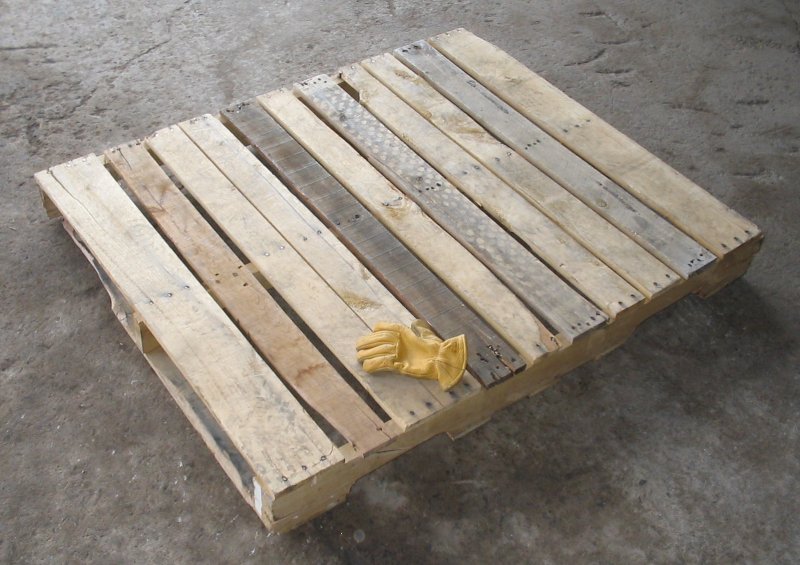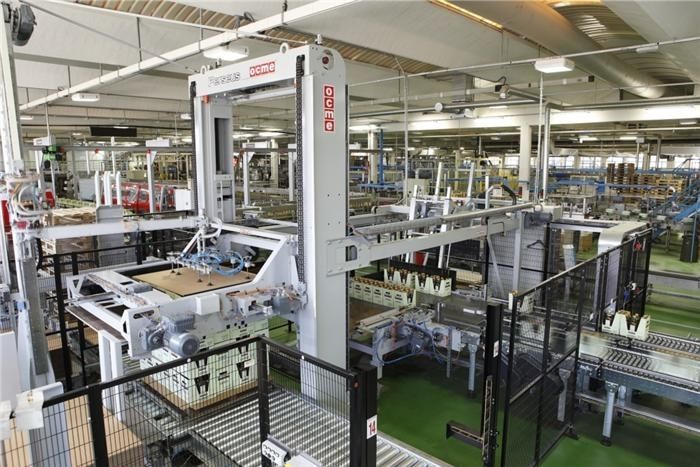|
Pallet Inverter
A pallet inverter or pile turner is a machine that is used to turn over full pallet loads of packages or products. The term pallet inverter is also used to cover machines that turn the palletised load through 90 degrees only. Use The reasons for needing to turn over a pallet are varied. The primary reason is have access to the bottom of the load without having to manually unload all of the boxes or bags. If a pallet or slip sheet is damaged. it can be replaced by inverting the load, replacing it, and re-inverting the load. Sometimes a manufacturer simply needs to turn their products to stop their contents settling. In some industries, it is necessary to transfer goods from one type of pallet to another – for example, when plastic pallets are used for on-site storage and wooden pallets are used for shipping. Some products require rapid freezing immediately after production and packaging. Processes can utilize ''freezer spacers'' between each tier of boxes on a pallet: the ... [...More Info...] [...Related Items...] OR: [Wikipedia] [Google] [Baidu] |
Pallet
A pallet (also called a skid) is a flat transport structure, which supports goods in a stable fashion while being lifted by a forklift, a pallet jack, a front loader, a jacking device, or an erect crane. A pallet is the structural foundation of a unit load, which allows handling and storage efficiencies. Goods in shipping containers are often placed on a pallet secured with strapping, stretch wrap or shrink wrap and shipped. Since its invention in the twentieth century, its use has dramatically supplanted older forms of crating like the wooden box and the wooden barrel, as it works well with modern packaging like corrugated boxes and intermodal containers commonly used for bulk shipping. In addition, pallet collars can be used to support and protect items shipped and stored on pallets. While most pallets are wooden, pallets can also be made of plastic, metal, paper, and recycled materials. Overview Containerization for transport has spurred the use of pallets because sh ... [...More Info...] [...Related Items...] OR: [Wikipedia] [Google] [Baidu] |
Production Line
A production line is a set of sequential operations established in a factory where components are assembled to make a finished article or where materials are put through a refining process to produce an end-product that is suitable for onward consumption Typically, raw materials such as metal ores or agricultural products such as foodstuffs or textile source plants like cotton and flax require a sequence of treatments to render them useful. For metal, the processes include crushing, smelting and further refining. For plants, the useful material has to be separated from husks or contaminants and then treated for onward sale. History Early production processes were constrained by the availability of a source of energy, with wind mills and water mills providing power for the crude heavy processes and manpower being used for activities requiring more precision. In earlier centuries, with raw materials, power and people often being in different locations, production was distribu ... [...More Info...] [...Related Items...] OR: [Wikipedia] [Google] [Baidu] |
Bulk Material Handling
Bulk material handling is an engineering field that is centered on the design of equipment used for the handling of dry materials. Bulk materials are those dry materials which are powdery, granular or lumpy in nature, and are stored in heaps.http://practicalmaintenance.net/wp-content/uploads/Maintenance-of-Ash-Handling-Plants-and-Pneumatic-Conveying-Systems.pdf Examples of bulk materials are minerals, ores, coal, cereals, woodchips, sand, gravel, clay, cement, ash, salt, chemicals, grain, sugar, flour and stone in loose bulk form. It can also relate to the handling of mixed wastes. Bulk material handling is an essential part of all industries that process bulk ingredients, including: food, beverage, confectionery, pet food, animal feed, tobacco, chemical, agricultural, polymer, plastic, rubber, ceramic, electronics, metals, minerals, paint, paper, textiles and more. Major characteristics of bulk materials, so far as their handling is concerned, are: lump size, bulk weight (densit ... [...More Info...] [...Related Items...] OR: [Wikipedia] [Google] [Baidu] |
Conveyor System
A conveyor system is a common piece of mechanical handling equipment that moves materials from one location to another. Conveyors are especially useful in applications involving the transport of heavy or bulky materials. Conveyor systems allow quick and efficient transport for a wide variety of materials, which make them very popular in the material handling and packaging industries. They also have popular consumer applications, as they are often found in supermarkets and airports, constituting the final leg of item/ bag delivery to customers. Many kinds of conveying systems are available and are used according to the various needs of different industries. There are chain conveyors (floor and overhead) as well. Chain conveyors consist of enclosed tracks, I-Beam, towline, power & free, and hand pushed trolleys. Industries where used Conveyor systems are used widespread across a range of industries due to the numerous benefits they provide. * Conveyors are able to safely tra ... [...More Info...] [...Related Items...] OR: [Wikipedia] [Google] [Baidu] |
Palletizer
A palletizer or palletiser is a machine which provides automatic means for stacking cases of goods or products onto a pallet. Manually placing boxes on pallets can be time consuming and expensive; it can also put unusual stress on workers. The first mechanized palletizer was designed, built, and installed in 1948 by a company formerly known as Lamson Corp. There are specific types of palletizers including the row-forming which were introduced in the early 1950s. In row-forming palletizing applications loads are arranged on a row forming area and then moved onto a different area where layer forming takes place. This process repeats until a full layer of goods and products are configured to be placed on a pallet. The in-line palletizer was developed in the 1970s when higher speeds were needed for palletizing. This palletizer type utilizes a continuous motion flow divider that guides the goods into the desired area on the layer forming platform. Robotic palletizers were introduced ... [...More Info...] [...Related Items...] OR: [Wikipedia] [Google] [Baidu] |
Slip Sheet
Slip sheets are thin, pallet-sized sheets made of plastic, heavy laminated kraft paperboard, or corrugated fiberboard and are used in commercial shipping, replacing traditional wooden pallets. The unit load is usually stretch wrapped or shrink wrapped for stability. Description The slip sheet is used as a pallet support device in vehicle delivery and transportation of products. When slip sheets are supported by a pallet board, flat load carrying surface, or a cart or fork lift truck, the structural strength of the slip sheet supports the product load's weight. With the slip sheet supported by one of these transportation devices the unit load can easily be transported both internally within a facility and externally between two facility locations. It helps to decrease the human intervention in order to provide safety and efficiency of the work. Types There are several types of slip sheets that can be used for the transportation of a unit load depending upon the desired use of th ... [...More Info...] [...Related Items...] OR: [Wikipedia] [Google] [Baidu] |
Pallets
A pallet (also called a skid) is a flat transport structure, which supports goods in a stable fashion while being lifted by a forklift, a pallet jack, a front loader, a jacking device, or an erect crane. A pallet is the structural foundation of a unit load, which allows handling and storage efficiencies. Goods in shipping containers are often placed on a pallet secured with strapping, stretch wrap or shrink wrap and shipped. Since its invention in the twentieth century, its use has dramatically supplanted older forms of crating like the wooden box and the wooden barrel, as it works well with modern packaging like corrugated boxes and intermodal containers commonly used for bulk shipping. In addition, pallet collars can be used to support and protect items shipped and stored on pallets. While most pallets are wooden, pallets can also be made of plastic, metal, paper, and recycled materials. Overview Containerization for transport has spurred the use of pallets because s ... [...More Info...] [...Related Items...] OR: [Wikipedia] [Google] [Baidu] |
Packaging Machinery
Packaging machinery is used throughout all packaging operations, involving primary packages to distribution packs. This includes many packaging processes: fabrication, cleaning, filling, sealing, combining, labeling, overwrapping, palletizing. Overview Some packaging operations cannot be accomplished without packaging equipment. For example many packages include heat seals to prepare or seal a package. Heat sealers are needed, even in slow labor-intensive operations. With many industries, the effectiveness of the heat seal is critical to product safety so the heat sealing operation must closely controlled with documented Verification and validation protocols. Food, drug, and medical regulations require consistent seals on packages. Proper equipment is needed. Automation Packaging operations can be designed for variable package sizes and forms or for handling only uniform packages, where the machinery or packaging line is adjustable between production runs. Certainly slow ... [...More Info...] [...Related Items...] OR: [Wikipedia] [Google] [Baidu] |




